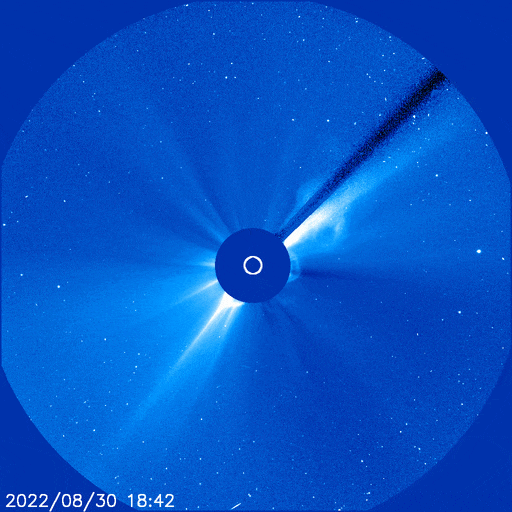
I morgentimene søndag 4. september fløy Solar Orbiter forbi[{” attribute=””>Venus for a gravity-assist maneuver that alters the spacecraft’s orbit, which will get it even closer to the Sun. As if trying to attract the orbiter’s attention as it cozied up to another body in the Solar System, the Sun flung an enormous ‘coronal mass ejection‘ straight at the spacecraft and planet. It was just two days before their closest approach – and the data are revealing.
On August 30, 2022, a large coronal mass ejection erupted from the Sun in the direction of Venus. Not long later, the powerful storm arrived at the second planet from the Sun. As the data continues to come in from Solar Orbiter, this strike reveals why ‘in situ’ monitoring of space weather and its effects on the bodies, and spacecraft, of the Solar System are so important.

Artist’s impression of Solar Orbiter making a flyby at Venus. Credit: ESA/ATG medialab
Fortunately, there was no damage or no negative effects on the spacecraft. Indeed, the ESA-
Så langt har Solar Orbiter vært begrenset til det samme planet som planetene, men fra februar 2025 og utover vil hvert møte med Venus øke sin banehelling, noe som får den til å “sprette” opp fra planet til solsystemet for å se av solens mystiske polare områder.
Denne tredje forbiflyvningen av Venus fant sted søndag klokken 01:26[{” attribute=””>UTC (Saturday at 9:26 p.m. EDT), when Solar Orbiter passed 12,500 km (7,800 miles) from the planet’s center, which is very roughly 6,000 km (3,700 miles) from its gassy ‘surface’. In other words, it passed a distance half the width of Earth.
Its distance from Venus, angle of approach, and velocity were all carefully planned to get the precise desired effect from the planet’s large gravitational pull – getting the spacecraft closer to the Sun than ever before.

Solar Orbiter Flight Control Team during pre-launch simulations in 2020. Credit: ESA
“The close approach went exactly to plan, thanks to a great deal of planning from our colleagues in Flight Dynamics and the diligent care of the Flight Control Team,” explains Jose-Luis Pellon-Bailon, Solar Orbiter Operations Manager.
“By trading ‘orbital energy’ with Venus, Solar Orbiter has used the planet’s gravity to change its orbit without the need for masses of expensive fuel. When it returns to the Sun, the spacecraft’s closest approach will be about 4.5 million km (2.8 million miles) closer than before.”
Understanding particles that pose a radiation risk
Data beamed back to Earth since Solar Orbiter encountered the solar storm shows how its local environment changed as the large CME whooshed by. Although some instruments had to be turned off during its close approach to Venus, in order to protect them from stray sunlight reflected off of the planet’s surface, Solar Orbiter’s ‘in situ’ instruments remained on, recording an increase in solar energetic particles, among other things.

This composite image shows a SOHO image of the Sun and an artist’s impression of Earth’s magnetosphere. Credit: Magnetosphere: NASA, the Sun: ESA/NASA – SOHO
Particles, mostly protons and electrons, but also some ionized atoms like Helium, are constantly emitted by the Sun. When particularly large flares and ejections of ten science instruments are delivering new insight into how the 11-year cycle of solar activity works. Ultimately, these findings will help us better forecast periods of stormy space weather and protect planet Earth from the Sun’s violent outbursts.

Solar Orbiter’s suite of ten science instruments that will study the Sun. There are two types: in situ and remote sensing. The in situ instruments measure the conditions around the spacecraft itself. The remote-sensing instruments measure what is happening at large distances away. Together, both sets of data can be used to piece together a more complete picture of what is happening in the Sun’s corona and the solar wind. Credit: ESA-S.Poletti
Goodbye, halo?
This recent CME illustrates a difficulty in space weather observations. As seen in this footage from

Large coronal mass ejection (CME) was recorded by the Solar and Heliospheric Observatory (SOHO) on August 30, 2022. The CME struck ESA’s Solar Orbiter spacecraft as it performed a flyby of Venus. Credit: ESA/NASA SOHO
It is tricky to determine if coronal mass ejections are coming towards Earth or moving away when viewed from Earth, because in both cases it appears to be expanding. One of the many benefits of the coming Vigil mission is that by combining the images taken from Earth’s direction and Vigil’s position at the ‘side’ of the Sun, the fifth Lagrange point, it will be easy and reliable to distinguish between an oncoming or departing storm.
Space weather gets deep
The Sun wields its influence on all the bodies of the Solar System. It’s the reason why no life could survive on the inner planets, as the sun makes their temperatures too hot and stripped away their atmospheres long ago.
As we venture from Earth to the Moon, it’s vital that we understand how space weather can affect human bodies, robots, communication systems, and plants and animals.

Solar Orbiter’s stellar views hint at Vigil’s future. Credit: ESA
As well as a wide range of tools to understand the Sun’s effect on Earth’s infrastructure, ESA’s Space Weather Service Network currently alerts teams flying missions throughout the Solar System of extreme space weather, with forecasts for Mercury, Venus, and